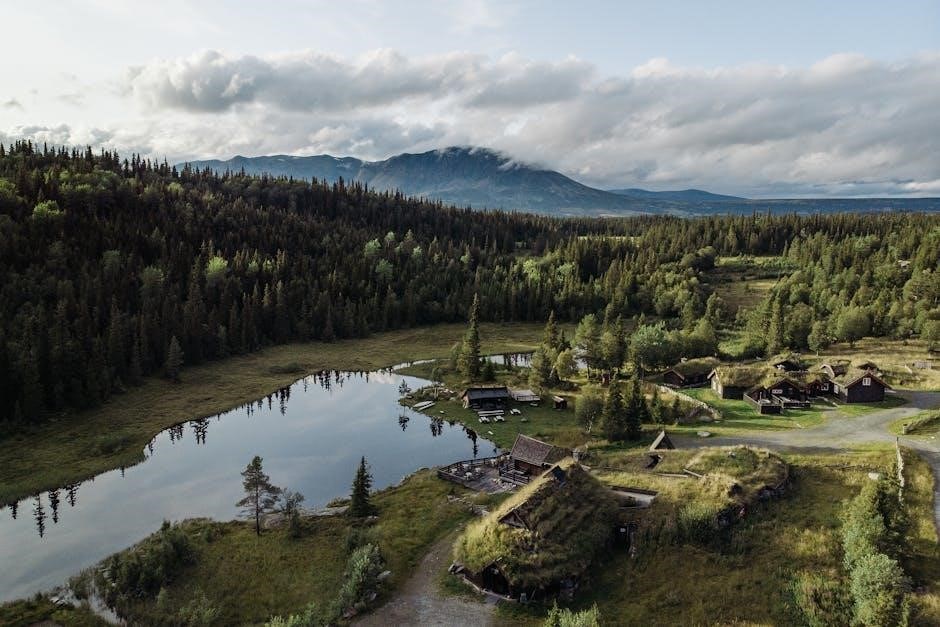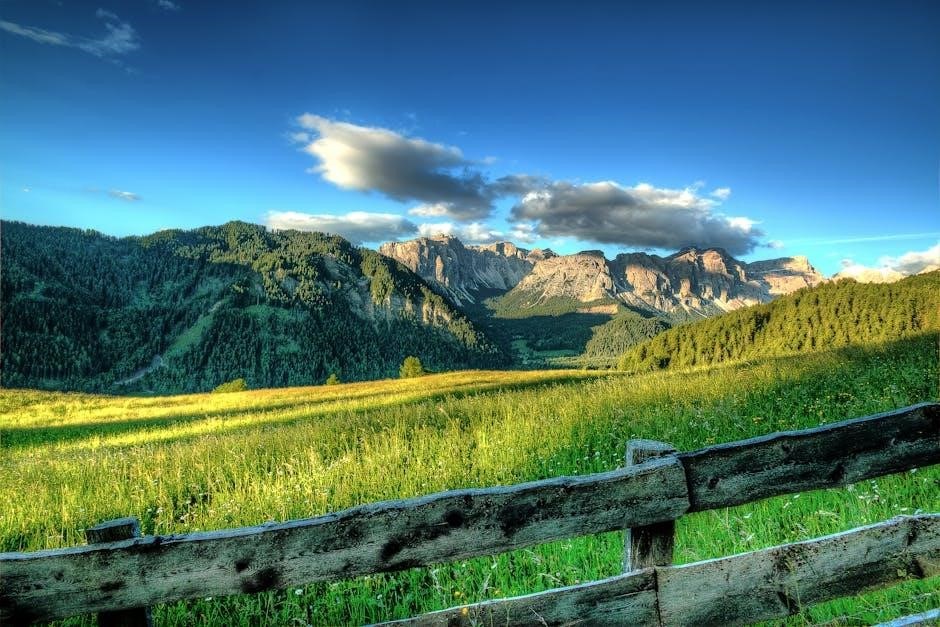Welcome to the ultimate guide for your first year in Stardew Valley! This guide will walk you through day-by-day strategies, essential tips, and key activities to ensure a successful start.
1.1 Understanding the Importance of Day-by-Day Planning
Day-by-day planning is crucial for maximizing efficiency in Stardew Valley. By organizing tasks like farming, fishing, and socializing, you can optimize energy use and progress. Each day presents opportunities to advance skills, build relationships, and unlock new content. Effective planning ensures you balance short-term goals with long-term aspirations, making every in-game day count toward a successful first year.
1.2 Setting Goals for Your First Year
Setting clear goals for your first year in Stardew Valley helps track progress and keeps gameplay focused. Aim to clear land, plant crops, unlock new areas, and build relationships. Balance farming, fishing, mining, and socializing to avoid burnout. Prioritize upgrading tools and expanding your farm. Participate in festivals and quests to earn rewards. Regularly evaluate your progress to stay motivated and adjust strategies as needed for a successful year.
Day 1: Laying the Foundation
Day 1 is crucial for setting up your farm and understanding the basics. Collect resources, plant parsnip seeds, and interact with villagers to establish a strong foundation for your journey.
2.1 Starting Your Farm and Initial Setup
Begin by collecting the free parsnip seeds from your house and clearing debris from your farm. Focus on energy management, as many actions consume stamina. Interact with Robin to understand farm basics and visit Willy to claim your fishing rod. Organize your farmhouse and prioritize tasks like planting seeds and chopping logs. These initial steps will set the stage for a productive first year in Stardew Valley.
2.2 Energy Management and Prioritizing Tasks
Effectively manage your energy by balancing farm work, fishing, and mining. Allocate tasks based on energy levels, ensuring you have enough stamina for essential activities; Prioritize clearing land and planting crops early in the day, leaving lower-energy tasks like foraging for later. Maintain an empty backpack slot to collect resources efficiently and eat small stacks of food to replenish energy. Proper time management will maximize your daily productivity in Stardew Valley.

First Week: Building Momentum
The first week sets the foundation for your farm and town integration. Focus on clearing land, planting initial crops, and unlocking new areas. Meet villagers to build connections and establish routines for long-term success.
3.1 Clearing Land and Planting First Crops
Start by clearing debris and rocks from your farm to create space for crops. Prioritize energy management on Day 1, as farming tasks consume stamina. Focus on planting high-value crops like Parsnip seeds, which are readily available. Use basic tools to till the soil and water your crops daily. Organize your farm layout to maximize efficiency; This early progress will set the stage for a productive first week and a successful harvest.
3.2 Unlocking New Areas and Meeting Villagers
As you progress, unlock new areas like the Mines and Skull Cavern by completing initial tasks. Meeting villagers is crucial for building relationships and accessing new items. Focus on energy management to explore and interact with NPCs. Giving gifts and engaging in conversations will strengthen friendships, opening up quests and opportunities. Prioritize unlocking key locations early to maximize resource gathering and social progress.
Spring Season: Key Activities
Welcome the season with planting parsnip seeds, clearing land, and managing energy wisely. Prioritize farming tasks and explore surrounding areas to set a strong foundation for growth.
4.1 Planting and Maintaining Crops
Begin by planting parsnip seeds, as they mature quickly and provide early income. Focus on clearing land efficiently and prioritize watering crops daily to ensure growth. Use fertilizers to boost yields and protect plants from pests. Regularly check crop health and harvest them on time to maximize profit. Upgrading your tools early will improve farming efficiency, allowing you to manage larger fields as the season progresses.
4.2 Fishing and Mining Strategies
Fishing and mining are essential for resources and income. Start fishing at the mountain lake or beach, upgrading your rod for better catches. In the Mines, focus on ores and gems, prioritizing coal for torches. Manage energy by balancing these activities with farming. Keep your inventory organized and upgrade tools early to improve efficiency. These pursuits complement farming, ensuring steady progression and resource gathering throughout the season.

Summer Season: Optimizing Income
Summer is key for income. Prioritize high-value crops and animal care. Attend festivals for rewards and relationship boosts. Manage energy wisely to balance activities effectively.
5.1 Managing Multiple Crops and Animals
Summer is ideal for growing high-value crops like Ancient Fruits and Melons. Plant them strategically to maximize profits. Rotate crops to maintain soil fertility and avoid depletion. Use quality irrigation systems to save time and energy. For animals, ensure coops and barns are upgraded to increase capacity. Collect eggs, milk, and wool daily to maintain production. Diversify livestock to boost income and create crafting materials. Balance crop and animal care for a thriving farm.
5.2 Participating in Festivals and Quests
Summer festivals like the Egg Festival and Flower Dance offer exclusive rewards and opportunities to boost relationships. Participate actively by completing festival-specific tasks. Quests from villagers unlock new items, areas, and storylines. Prioritize completing bundles for the Community Center to earn rewards and progress. Engaging in these activities not only enhances your farm’s prosperity but also strengthens your connections within Pelican Town, making your first year even more rewarding and enjoyable.
Fall Season: Harvest and Preparation
- Focus on harvesting crops like Pumpkins and Cranberries, essential for the Stardew Valley Fair.
- Store surplus crops to maintain resources for winter.
- Prepare for the Fair by ensuring high-quality items are ready.
6.1 Harvesting and Storing Crops
In the fall, prioritize harvesting high-value crops like Pumpkins, Cranberries, and Hops. Regularly check your fields to avoid overripe plants. Store excess crops in chests or silos to preserve them for winter. Consider upgrading your silo to increase storage capacity. Organize your inventory to ensure easy access to items needed for cooking, crafting, or selling. Proper management will maximize profits and prepare you for the Stardew Valley Fair.
6.2 Preparing for the Stardew Valley Fair
Preparing for the Stardew Valley Fair, held on Fall 16, is crucial. Focus on growing high-quality crops like Pumpkins and Cranberries, and craft top-tier items. Store your best produce in chests to keep them fresh. Review the fair’s judging criteria to maximize your chances of winning rewards. Organize your inventory to ensure easy access to entries. This event is a great opportunity to earn gold and items, so plan ahead to make the most of it.

Winter Season: Focus on Indoor Activities
Winter is ideal for crafting, cooking, and upgrading tools. Focus on indoor projects to prepare for spring and maximize productivity during the colder months.
7.1 Crafting and Cooking Essentials
Winter is the perfect time to focus on crafting and cooking. Prioritize creating essential items like quality fertilizer and cheese presses to boost future farming efficiency. Experiment with new recipes to restore energy and unlock buffs. Crafting higher-value items like pickaxes and axes will aid in mining and foraging. Dedicate time to cooking hearty meals that provide energy and stamina boosts, ensuring you’re prepared for spring. Balance crafting with other indoor activities to maximize productivity.
7.2 Building Relationships with Villagers
Winter is an ideal time to focus on building friendships with Pelican Town’s villagers. Consistently talk to them, give gifts they love, and complete quests to boost heart levels. Attend festivals like the Night Market to interact with multiple villagers at once. Reaching higher heart levels unlocks new cutscenes, quests, and even romantic opportunities. Strong relationships also grant benefits like improved store offerings and access to rare items. Prioritize meaningful interactions to foster lasting connections.
Skill Development and Mastery
Focus on leveling up farming, fishing, and mining skills by consistently practicing and upgrading tools. Each level unlocks new recipes, improved gear, and enhanced efficiency, boosting overall productivity.
8.1 Understanding the Skill Mastery System
Stardew Valley’s skill mastery system rewards consistent practice. Each skill, like farming, fishing, or mining, progresses with use, unlocking new abilities and tools at higher levels. Mastery enhances efficiency, allowing better resource gathering and crafting. Regular practice is key to achieving skill milestones by year’s end, ensuring a strong foundation for future growth and maximizing productivity in Year 1.
8.2 Maximizing Skill Levels by Year End
Relationship Building and Marriage
Building strong relationships with villagers is key to unlocking new opportunities. Focus on giving gifts, completing quests, and engaging in meaningful conversations to boost friendship levels and romance.
9.1 Building Friendships with Villagers
Building friendships with villagers is a cornerstone of Stardew Valley. Start by giving gifts, especially loved items, to increase friendship points. Engage in daily conversations and complete quests to unlock new storylines. Attend festivals to strengthen bonds and participate in group activities. Focus on consistent interaction, as neglecting villagers for 30 days can lower relationships. Building trust and rapport opens doors to new opportunities and deepens your connection to Pelican Town.
9.2 Pursuing Romance and Getting Married
To pursue romance in Stardew Valley, focus on building an 8-heart friendship with your chosen bachelor or bachelorette; Give loved gifts, complete their quests, and engage in meaningful conversations. Once at 8 hearts, purchase a Mermaid’s Pendant or a bouquet from Pierre to propose. After marriage, your spouse will help with farm tasks and provide unique dialogue. Marriage also unlocks new heart events and shared goals, enriching your gameplay experience.

Year-End Review and Preparation
End Year 1 by evaluating your progress, organizing resources, and planning for Year 2. Ensure crops are harvested, tools are upgraded, and goals are set for future success.

10.1 Evaluating Your Progress
Evaluating your progress at the end of Year 1 is crucial for understanding your achievements and identifying areas for improvement. Check your farm’s condition, inventory, and skill levels. Review your relationships with villagers and financial status. Ensure all crops are harvested, tools are upgraded, and long-term goals are aligned. This reflection will help you plan effectively for Year 2 and beyond.
10.2 Planning for Year 2
Planning for Year 2 involves setting clear goals, such as expanding your farm, upgrading tools, or pursuing advanced skills. Budget for essential upgrades and prioritize infrastructure improvements. Focus on enhancing relationships and unlocking new content. Prepare for upcoming challenges like the Stardew Valley Fair and future festivals. Use insights from Year 1 to optimize your strategy and ensure a strong foundation for long-term success in Stardew Valley.
